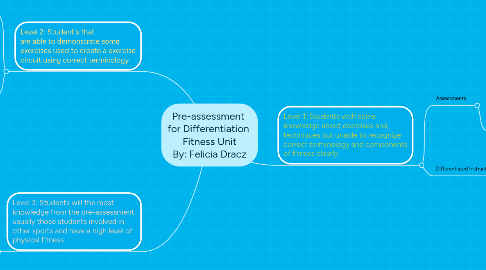
1. Level 2: Student's that are able to demonstrate some exercises used to create a exercise circuit using correct terminology
1.1. Assessments
1.1.1. Assessments for this group of students might include Think-Pair-Share where students get to work together to expand their knowledge with a partner. For example; students can be assigned to a specific sport in groups where they peer-assess one another. Peer assessing will test their individual knowledge and allows them to work together to share ideas. Giving this group of students small tips, prompts, and cues is suitable for this level of knowledge. Scaffolding strategies should be planned for implementation into lesson plans.
1.2. Differentiated Instruction
1.2.1. These students will work closely with other students. They will learn more self-directed learning by acting as the teacher rather then the student. They will work in pairs to share ideas (exercises/fitness routines) that they are familiar with. Students will discuss in more detail what muscle groups their exercises target. These students will demonstrate for their classmates what they came up with and this will also allow for the teacher to assess the level continuously.
2. Level 3: Students will the most knowledge from the pre-assessment, usually those students involved in other sports and have a high level of physical fitness
2.1. Assessments
2.1.1. This group of students needs the most challenging assessments. Grouping these students together will increase competitiveness and create stronger knowledge between one another. Often students in the group will have the strongest physical ability levels. They can help to lead as role models for other students. Leading the group, etc. These students could also be assessed reaching high goals, creating an initial assessment for circuit performance and a weekly goal to follow.
2.2. Differentiated Instruction
2.2.1. These students that are comfortable performing exercises. There knowledge about physical fitness plans is the highest. These students will have to think of different exercises that can be used with the different equipment used in their PE class. These students can work individually or together to find videos or research where they can implement new exercises for their classmates. Students could be given specific muscle groups to target specifically. They will need to expand their knowledge to find something new based on the goals of the unit.
3. Level 1: Students with some knowledge about exercises and techniques but unable to recognize correct terminology and components of fitness clearly
3.1. Assessments
3.1.1. Students will be assessed formatively often throughout the Unit of Fitness. Assessments might include one-one-feedback, demonstrations for the teacher or peers and giving student modifications frequently. Having students show proper the safe execution of exercises (Do's) and (Don'ts) will distinguish more clearly the important of technique and form.
3.2. Differentiated Instruction
3.2.1. These students will be provided with the most background knowledge going into the unit. These students will watch videos of various exercises, that will introduce unit knowledge. Videos might include how to use one piece of equipment in many ways. Videos might also be from previous students that created a circuit plan. Students will work more closely with the teacher until clearly understood.
3.2.1.1. https://www.youtube.com/watch?v=540_pQ05JbI https://www.youtube.com/watch?v=eyQithc9c7Q
